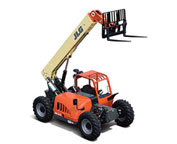
Forklift Mast Chain - Utilized in various applications, leaf chains are regulated by ANSI. They can be used for lift truck masts, as balancers between counterweight and heads in some machine devices, and for tension linkage and low-speed pulling. Leaf chains are occasionally also known as Balance Chains.
Features and Construction
Constructed of a simple link plate and pin construction, steel leaf chains is identified by a number which refers to the pitch and the lacing of the links. The chains have particular features like for instance high tensile strength for every section area, which allows the design of smaller devices. There are B- and A+ kind chains in this series and both the AL6 and BL6 Series have the same pitch as RS60. Finally, these chains cannot be powered using sprockets.
Handling and Selection
In roller chains, the link plates have a higher fatigue resistance because of the compressive tension of press fits, yet the leaf chain just has two outer press fit plates. On the leaf chain, the most allowable tension is low and the tensile strength is high. When handling leaf chains it is essential to consult the manufacturer's instruction booklet so as to guarantee the safety factor is outlined and use safety guards all the time. It is a good idea to exercise extreme caution and use extra safety measures in functions wherein the consequences of chain failure are severe.
Higher tensile strength is a direct correlation to the utilization of a lot more plates. As the use of much more plates does not enhance the maximum permissible tension directly, the number of plates could be limited. The chains need frequent lubrication for the reason that the pins link directly on the plates, producing a really high bearing pressure. Making use of a SAE 30 or 40 machine oil is often advised for nearly all applications. If the chain is cycled over one thousand times day after day or if the chain speed is more than 30m for every minute, it would wear extremely rapidly, even with continual lubrication. Therefore, in either of these situations using RS Roller Chains will be more suitable.
The AL-type of chains should only be utilized under certain situations such as when wear is really not a big issue, when there are no shock loads, the number of cycles does not go beyond a hundred on a daily basis. The BL-type would be better suited under other conditions.
The stress load in components will become higher if a chain with a lower safety factor is selected. If the chain is also utilized among corrosive situations, it can easily fatigue and break very quick. Doing frequent maintenance is essential when operating under these kinds of conditions.
The kind of end link of the chain, whether it is an inner link or outer link, determines the shape of the clevis. Clevis connectors or also called Clevis pins are made by manufacturers but usually, the user provides the clevis. A wrongly constructed clevis can lessen the working life of the chain. The strands should be finished to length by the producer. Refer to the ANSI standard or phone the manufacturer.
![]() Click to Download the pdf
Click to Download the pdf
Forklift Parts








Lift Parts Express
TOLL FREE: 1-888-695-7994
LOCAL: (623) 900-4309
4980 S Alma School Rd A2-247
Chandler, Arizona
forkliftpartschandler.com
Email Us
About Us



